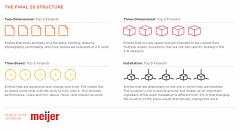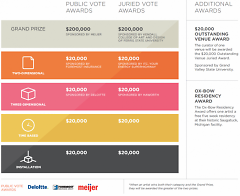In an effort to continue broadening the discussion between public and expert opinions, ArtPrize has changed the prize system for this year which may affect how the public decides to vote. The much talked about Top 10 will become the Final 20, split into four groups of five finalists. During the first round of voting, the public still votes for any and all artwork they like. This year, after that first round the Round Two selections are broken into categories. The four categories are Two-Dimensional, Three Dimensional, Time-Based and Installation.
For the first time this year, the public votes and juried votes will run along parallelled tracks. Both the jury and the public will be mulling over the same four categories, awarding prizes with the same amount of money for each category at $20,000 and awarding an equal Grand Prize of $200,000. With awards at a cumulative $280,000 for juried awards and $280,000 for public vote awards, the total awards monies comes to $560,000.
“We wanted more comparison between the public and the juried picks," says Kevin Buist, Director of Exhibitions for ArtPrize. "There was already a complicit comparison that people spoke about, but the prize differences didn't lend itself to that. The original grand jury prize was a huge prize on its own, but at ArtPrize it was overshadowed by the public prize. Comparison can begin sooner. It’s fun to theorize about who picks what and why- this discussion is one of the things that makes ArtPrize what it is.”
Voting requires registering in person. Visitors may go to a voting site, the ArtPrize HUB or any Exhibition Center. Exhibition Centers include Frederick Meijer Gardens & Sculpture Park, Grand Rapids Art Museum, Kendall College of Art and Design, Gerald R. Ford Presidential Museum, and the Urban Institute of Contemporary Art. Registering requires a government-issued photo ID- either a driver’s license, state ID or passport. Those using a smartphone app can also register to vote on ArtPrize's free mobile app on an iPhone, Android or iPad at Apple orAndroid. Once the app is downloaded, while downtown in the ArtPrize area with mobile device in hand, a phone's GPS system can verify that a voter is in the ArtPrize district to activate voting. The app will automatically ask if you'd like to register. Click "yes" and the app is then able to record votes. Visitors must be 16 years old to vote.
There are three ways to cast votes once accounts have been activated downtown- online at artprize.org, on the ArtPrize app mentioned above or via text message. Online and on the app, voters sign in and click “vote” on any entry that they choose. To vote by text, mobile numbers are added to an ArtPrize account and instructions are provided in a follow up text message. Once set up, votes can be placed by texting Artist Vote Codes to 808080 to cast a vote. Each entry will be displayed with a unique five-digit Artist Voting Code. All of the artist entries will also have their category listed.
Round One of voting, the free-for-all, see-as-much-art-as-you-can round of the voting is from September 24, 12 p.m. to October 4, 11:59 p.m. This is when visitors vote for anything they would like to see make it to the top 20. The Final 20 Announcement will happen at 2:00 p.m. on October 5 in Rosa Parks Circle. These 20 finalist will then be in competition for the four category awards and the Grand Prize.
In Round Two, voters select which of these five finalist they’d like to see win their category. It's also when the votes are compiled to see which entry gets the most votes overall for the Grand Prize.
“The change in the voting was really driven by the change in the structure of the awards. We wanted them to be the same structure and money. In past years these were different. The process of voting is totally unchanged- you can vote for what you like, you don't need to be aware of the changes to vote. The user end experience is still essentially the same," says Buist. "One change in second round voting is that it works like first round voting in that you can vote for as many entries as you like. It supports the same open voting. You can vote for all the Two-Dimensional art because that’s what you like. Or you can vote for one entry per category, picking your own favorite. Or you can vote for all 20 because you like them.”
Participants will be able to see and change their votes anytime during each round by deselecting that entry. The final selections will be announced at the ArtPrize Awards on October 10 starting at 7:45 p.m., which the public can see at Rosa Parks Circle or live on WOODTV 8.
The Rapidian, a program of the 501(c)3 nonprofit Community Media Center, relies on the community’s support to help cover the cost of training reporters and publishing content.
We need your help.
If each of our readers and content creators who values this community platform help support its creation and maintenance, The Rapidian can continue to educate and facilitate a conversation around issues for years to come.
Please support The Rapidian and make a contribution today.


